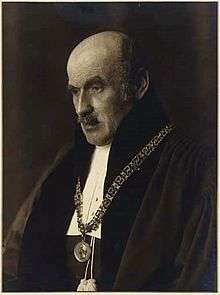Karl Vossler
Karl Vossler (6 September 1872, in Hohenheim – 19 September 1949, in Munich) was a German linguist and scholar, and a leading Romanist.[1] Vossler was known for his interest in Italian thought, and as a follower of Benedetto Croce. He declared his support of the German military by signing the Manifesto of the Ninety-Three in 1914. However, he opposed the Nazi government, and supported many Jewish intellectuals at that time.
Karl Vossler | |
|---|---|
 Karl Vossler (1926) | |
| Born | 6 September 1872 |
| Died | 19 September 1949 (aged 77) |
| Occupation | Romanist |
In 1897 he received his doctorate from the University of Heidelberg, and in 1909 was named a professor of Romance studies at the University of Würzburg. From 1911 onward, he taught classes at the University of Munich.[2]
Works by Vossler published in English
- "Mediaeval culture; an introduction to Dante and his times"; translated by William Cranston Lawton (1929).
- "The spirit of language in civilization"; translated by Oscar Oeser (1932).
- "Jean Racine"; translated by Isabel and Florence McHugh (1972).[3]
gollark: I read somewhere that the really low price is more of a marketing gimmick, hence why lots of places have a quantity limit, and the price of the version with headers reflects the actual price more accurately.
gollark: It *can work* as one, sure. Although so can ESP32 microcontroller things, which might be cheaper.
gollark: My tab count has been beaten? Troubling.
gollark: I can even get away with 700 open tabs with some fraction of my 8GB of RAM. Obviously not all of them are actively loaded and running.
gollark: Why are you showing screenshots of an image open in something instead of just uploading said image?
See also
Notes
- Darko Suvin called him The leading Romanist of pre-Nazi times
- Thibaut - Zycha / edited by Walther Killy Dictionary of German Biography
- HathiTrust Digital Library (published works)
External links
- Newspaper clippings about Karl Vossler in the 20th Century Press Archives of the ZBW
- Critical edition of Karl Vossler's translations of the Divine Comedy in German at academia.edu
This article is issued from Wikipedia. The text is licensed under Creative Commons - Attribution - Sharealike. Additional terms may apply for the media files.